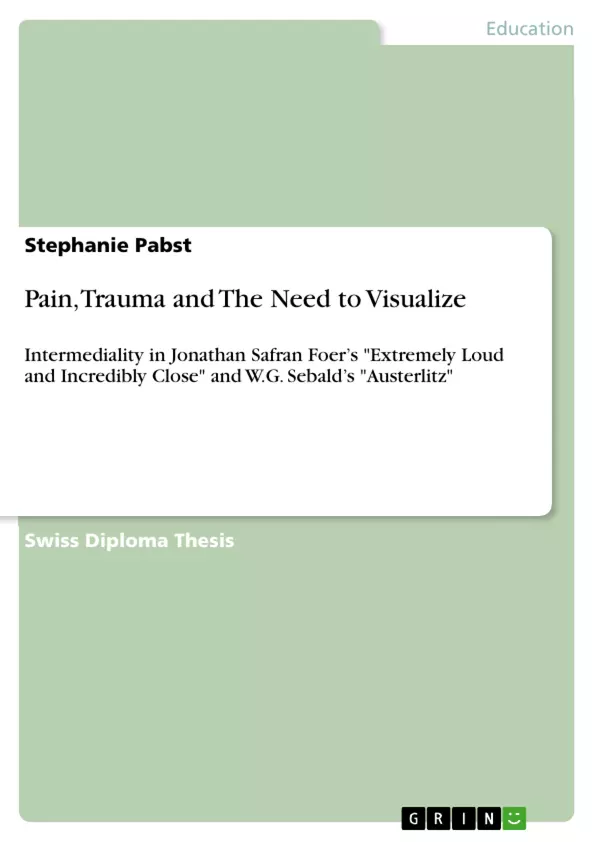W.G. Sebald and Jonathan Safran Foer stem from a different background in cultural, historical and local terms. Whereas Austerlitz is the last work of Sebald, which he finished shortly before his unexpected death, Extremely Loud and Incredibly Close is only Foer’s second novel, finished at the age of 27. However, both novels do not only both circle the subjects of trauma through war, the loss of parents by the hand of the enemy and the impact of memory. They also both use graphic representations as an autonomous layer in their narratives.
These graphic representations – photographs, maps, drawings, flip-book collections, etc. – are generally used in various ways to visualize meaning. The main protagonists, Austerlitz and Oskar, serve as both the collectors and creators of these representations within the narratives. As different as they are, both Austerlitz and Oskar, as well as Oskar’s grandparents, have suffered traumatic experiences by war and the loss of loved ones. The pictures that have been integrated in the narratives execute various functions on different levels along the way of their stories. On the intrafictional level, they act as visualizations of pain and trauma, proofs of existence and identity, evidence of history, media of documentation and verification, surrogates of experience and means of expression. On the extrafictional level, they serve not only as a means to carry on with the narrative on a visual level, but also as a reminder that pictures are always open to numerous interpretations and do not necessarily contribute to authentication, realization and truth as they are often perceived to do in everyday life. Rather, they give way to fictionalization, and to the construction of one’s very own version of an explanation, which can be either a way of coming to terms with received trauma or of impeded recovery. The aim of this thesis is, on one hand, to closely examine and compare the functions of images in both narratives, whether material or verbal, although the emphasis will be on photographs, and the way they interact with the written text. On the other hand, the thesis tries to educe the statements Sebald and Foer endeavor to make by pursuing intermedial strategies.
Inhaltsverzeichnis (Table of Contents)
- Introduction
- Theoretical Background
- State of Research
- Word and Image
- Terminology
- Mediality
- The Nature of Text and Picture
- Intermediality
- The Concept of Intermediality
- An Abstract of Intermediality in Literature
- Photography
- Terminology
- The Nature of Photography
- Intermediality in Austerlitz and Extremely Loud and Incredibly Close
- The Use of pictures on the intrafictional Level
- Memory and Identity
- Evidence, Knowledge and Truth
- Documenting and Preserving
- Surrogating Experience
- Communicating and Expressing Oneself
- Conclusion
- The Use of Pictures on the Extrafictional Level
- Illustration
- Narration and Plot Incentives
- Authentication
- Fictionalization of Photographs in Foer
- Art vs. Documentary
- Fictionalization of Photographs in Sebald
- Reader Involvement
- Text Substitution
- Creation of Atmosphere
- Omnipresence of Death and Suffering
- Creation of Blind Fields
- Pictures and Images of Buildings
- Picture and Image Networks
- Conclusion: Prompting Reflections on the Medium "Photography"
- The Use of pictures on the intrafictional Level
- Conclusion
Zielsetzung und Themenschwerpunkte (Objectives and Key Themes)
This paper aims to analyze the functions of images, specifically photographs, in the novels *Austerlitz* by W.G. Sebald and *Extremely Loud and Incredibly Close* by Jonathan Safran Foer. The study explores how these images interact with the written text and contribute to the narratives' overall meaning. The paper examines the ways in which both authors utilize intermedial strategies to convey themes related to trauma, memory, and identity.- The role of photographs in visualizing pain and trauma
- The use of images as evidence and documentation of history
- The impact of photographs on memory and identity formation
- The interplay between fictionalization and reality in the use of pictures
- The ways in which images prompt reflections on the medium of photography itself
Zusammenfassung der Kapitel (Chapter Summaries)
The introduction sets the stage by introducing the two authors and their respective novels, highlighting their shared thematic concerns related to World War II trauma and the use of images as narrative elements. The chapter also introduces the key protagonists, Austerlitz and Oskar, and their unique relationships with photographs. The theoretical background section provides a foundation for the analysis by exploring existing research on the relationship between word and image. It examines key concepts such as terminology, mediality, and the nature of text and picture, as well as the theoretical framework of intermediality. The chapter concludes with a discussion of photography, focusing on its terminology and nature. The chapter "Intermediality in Austerlitz and Extremely Loud and Incredibly Close" delves into the specific ways in which pictures are used in the novels on both the intrafictional and extrafictional levels. The analysis explores the functions of pictures in visualizing pain and trauma, documenting history, and constructing memory and identity. It also examines the role of pictures in shaping reader involvement and the interplay between fictionalization and reality in their use. The conclusion chapter will draw together the key findings and provide a summary of the paper's main arguments.
Schlüsselwörter (Keywords)
This paper examines the interplay of word and image in literary narratives, focusing on the use of photographs in *Austerlitz* by W.G. Sebald and *Extremely Loud and Incredibly Close* by Jonathan Safran Foer. Key themes explored include trauma, memory, identity, intermediality, fictionalization, and the nature of photography.- Arbeit zitieren
- Lic. phil. hist/master of arts Stephanie Pabst (Autor:in), 2008, Pain, Trauma and The Need to Visualize, München, GRIN Verlag, https://www.grin.com/document/151567



